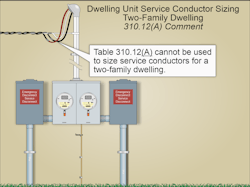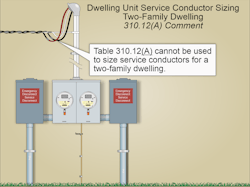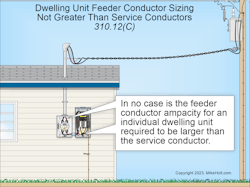Courtesy of www.MikeHolt.com
Q. How do you size a dwelling unit service and feeder conductor?
See answer below.
A. As per Sec. 310.12 [Dwelling Services and Feeders], dwelling unit services and feeders can be sized per the following:
(A) Services. Service conductors supplying the entire load associated with a one-family dwelling unit can be sized per Table 310.12(A) where there is no conductor ampacity adjustment or correction as required by Sec. 310.15.
Table 310.12(A) cannot be used to size service conductors for two-family or multifamily dwelling buildings. (Fig. 1)
(B) Feeders. Feeder conductors supplying the entire load associated with an individual dwelling unit can be sized per Table 310.12(A).
(C) Feeder Conductors Not Greater Than Service Conductors. The feeder conductor ampacity for an individual dwelling unit is not required to be larger than the service conductor. (Fig. 2)
(D) Neutral Conductors. Neutral conductors are permitted to be sized smaller than the phase conductors if the requirements of Sec. 220.61 and Sec. 230.42(C) for service conductors, or the requirements of Sec. 215.2(A)(2) and Sec. 220.61 for feeder conductors are met.
These materials are provided to us by Mike Holt Enterprises in Leesburg, Fla. To view Code training materials offered by this company, visit www.mikeholt.com/code.
About the Author

Mike Holt
Mike Holt is the owner of Mike Holt Enterprises (www.MikeHolt.com), one of the largest electrical publishers in the United States. He earned a master's degree in the Business Administration Program (MBA) from the University of Miami. He earned his reputation as a National Electrical Code (NEC) expert by working his way up through the electrical trade. Formally a construction editor for two different trade publications, Mike started his career as an apprentice electrician and eventually became a master electrician, an electrical inspector, a contractor, and an educator. Mike has taught more than 1,000 classes on 30 different electrical-related subjects — ranging from alarm installations to exam preparation and voltage drop calculations. He continues to produce seminars, videos, books, and online training for the trade as well as contribute monthly Code content to EC&M magazine.




